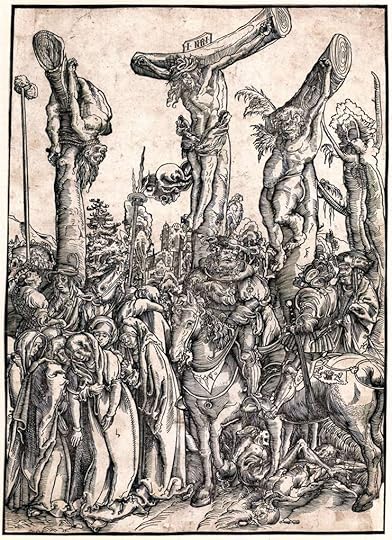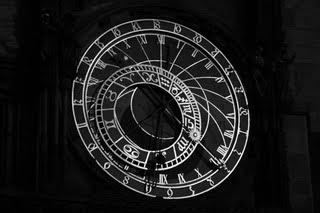Stephen Morris's Blog, page 33
April 23, 2017
Walpurgis Night

PRAGUE, CZECH REPUBLIC – APRIL 30, 2013: Participants of the costumed parade at the Witches Night carry a straw witch over the Charles Bridges in Prague, Czech Republic.
Walpurgis Night is the English translation of Walpurgisnacht, one of the Dutch and German names for the night of 30 April, so called because it is the eve of the feast day of Saint Walpurga, an 8th-century English missionary to the Franks. In Germanic folklore, Walpurgisnacht, also called Hexennacht, literally “Witches’ Night”, is believed to be the night of a witches’ meeting on the Brocken, the highest peak in the Harz Mountains, a range of wooded hills in central Germany between the rivers Weser and Elbe. May 1, also known as May Day and Beltane, was long celebrated in pre-Christian Europe as a highpoint of the magical year and many of the traditions and practices associated with it carried over into the celebration of Walpurga’s festival.
In much of Central Europe today, Walpurgis Night has become a holiday similar to Hallowe’en in the United States. People dress up as witches and go out to party — as in the photo above. There is often lots of drinking! In many places, a witch is burnt in effigy. In Prague, Walpurgis Night — Čarodějnice in Czech — is a very popular holiday. There are two Central European holidays that I would love to arrange to attend sometime… one is the Krampus parades in Salzburg in early December and the other is Walpurgis Night in Prague! (I guess another holiday I’d like to see sometime are the Midsummer bonfires in late June. Anybody want to join me? Maybe we can arrange a group to go together to one of these holidays!)
(A chapter of Come Hell or High Water, Part One: Wellspring happens on Čarodějnice.)
You can also read my 2014 post about Walpurgis Night if you want.
The post Walpurgis Night appeared first on Stephen Morris, author.
April 17, 2017
Pysanky Can Save the World

My collection of decorated eggs from Prague and Salzburg on display as an Easter egg tree in 2015.
Pysanky are the decorated eggs in Ukraine or other Slavic areas which are a very important part of the holiday season. It is important to keep making new pysanky every year to replace those that were broken by accident last year because the pysanky keep an evil dragon away from the earth. The more pysanky there are in the world, the further away the dragon must hide. But if there are too few pysanky, then the dragon can come closer and if there are really not enough pysanky in the world then the dragon can eat the earth!
Easter baskets were traditionally baskets of holiday food (meat, cheese, eggs — all the things that people were supposed to be fasting from during Lent!) that were brought to church to be blessed. Easter Monday was a good time to keep eating what was in the Easter baskets as well as enjoy the decorations and displays of Easter eggs. In many parts of Central Europe, people make “Easter trees” to hang their elaborately decorated Easter eggs on.
Pysanky were thought to protect households from evil spirits, catastrophe, lightning and fires. Pysanky with spiral motifs were the most powerful, as the demons and other unholy creatures would be trapped within the spirals forever.
Pysanky held powerful magic, and had to be disposed of properly, lest a witch get a hold of one. She could use the shell to gather dew, and use the gathered dew to dry up a cow’s milk. The witch could also use bits of the eggshell to poke people and sicken them. The eggshell had to be ground up very finely (and fed to chickens to make them good egg layers) or broken into pieces and tossed into a running stream.
The cloth used to dry pysanky was powerful, too, and could be used to cure skin diseases. And it was considered very bad luck to trample on a decorated egg -– God would punish anyone who did with a variety of illnesses.
There were superstitions regarding the colors and designs on the pysanky. One old Ukrainian myth centered on the wisdom of giving older people gifts of pysanky with darker colors and/or rich designs, for their life has already been filled. Similarly, it is appropriate to give young people pysanky with white as the predominant color because their life is still a blank page. Girls would often give pysanky to young men they fancied, and include heart motifs. It was said, though, that a girl should never give her boyfriend a pysanky that has no design on the top and bottom of the egg, as this might signify that the boyfriend would soon lose his hair.
The post Pysanky Can Save the World appeared first on Stephen Morris, author.
April 10, 2017
Holy Week Folklore

A detail showing Christ and the two theives on their crosses from “The Crucifixion” by Cranach the Elder (woodcut from approx. 1500-1504)
Holy Week, the days between Palm Sunday and Easter, is one of the most important and busiest times of the year in traditional European societies. Everyone is busy baking and cleaning and preparing for the great festival. There are many church services, especially at the end of the week on Thursday, Friday, and Saturday.
One of the more fascinating or frightening folktales of Holy Week tells us that in Prague and the Czech countryside, underground vaults, caves, and holes that contain hidden treasure will open up shine with a faint light as the Passion is chanted in church. A treasure-seeker can go outside church then and see these places and mark them to come back later. Or, if the treasure-seeker can’t wait to get rich, he can go inside the caves right then but he must get out before the last verse of the Passion reading is complete as the vault or cave will shut when the reading is complete and the treasure-seeker will be trapped inside until the next year.
In Russia, the tale is told that anyone who dies on Good Friday will be ushered directly into heaven just as the Good Thief was. (Many artists who painted depictions of the two thieves actually used the bodies of criminals who had been executed on the wheel as their models as no one was crucified any more; if you look closely, you can still see the thieves’ limbs twisted and bent in strange ways that don’t match descriptions of crucifixions because of their torture on the wheel.)
Much of the folklore associated with Holy Week involves protection of various sorts: To protect against the evil eye, wax from candles burned in church during the Holy Week services would be stuck to the heads of children or animals. Hanging a wreath on the door after sunset on Good Friday will protect the house against lightning. Hot cross buns baked on Good Friday and hung in the kitchen will protect against poverty and if they are hug over the bed, will protect against nightmares.
The post Holy Week Folklore appeared first on Stephen Morris, author.
April 6, 2017
What Do I Write?

Evil and black magic lurk in the shadows of Prague beneath The Astronomical Clock on the Old Town Square. (photo by Joseph O’Neill, 2016)
What Do I Write?
What do the COME HELL OR HIGH WATER trilogy and the STORM WOLF novel have in common? They are supernatural/fantasy thrillers that straddle timelines and cultures.
The Come Hell or High Water trilogy alternates between 1350s Prague and contemporary Prague. A witch curses the city in the 1350s and the curse is reawakened in the modern city; the curse works its way through the life of the town in both time periods as a handful of people in each period race to stop it before Prague is destroyed.
Storm Wolf follows the adventures of Alexei, the last werewolf in 1880s Estonia who is driven to become a killer and frantically searches throughout Estonia, Latvia, Lithuania, Poland, and Bohemia for a sorcerer who can save him from the wolf-magic.
All the fantastic or magickal aspects of my novels are based on authentic medieval and Renaissance occult beliefs or practices; these are the real deal! (You can use them as recipe books, if you want. This is what people actually did if they wanted to use the supernatural to achieve their goals.) The books also incorporate local legends and history so that you get a taste of what it was really like in Central Europe or the Baltic States in the Middle Ages, the late 19th century, or now.
I’m currently working on Earth to Earth, Ashes to Ashes which is a novel about an Irish female vampire and the ghost of a witch who have kidnapped three high school boys from Waterford in August, 2002; their uncle, a professor of Irish folklore, and a graduate student try to rescue them from the vampire and the witch before they are lost forever in the Otherworld.
You can subscribe to my email list to get seasonal reading suggestions (who doesn’t need a good book for the beach? Or to curl up with in the winter as the snow falls outside?) as well as hear about my upcoming projects. See the spot over to the right? Where it says “Newsletter” and “Subscribe?” Just type your email in the box there and click “Subscribe.” Thank you for keeping in touch!
Now, you can HOP to the next blog on the tour! Or here.
Step #5 – Be sure you mark your calendar! As a Blog Hop participant, you will be responsible for checking your link and the Blog Hop once it is live to confirm it works.
The goal is to create a kind of “daisy chain” that readers can follow from site to site to B2BCyCon.com to site.

The post What Do I Write? appeared first on Stephen Morris, author.
April 3, 2017
April 7: National Beer Day

Got hiccups? Plunge a dagger into a mug of beer and then drink it all in one breath. You’ll be cured!
National Beer Day celebrates the end of Prohibition with the Cullen-Harrison Act, which went into effect on April 7, 1933.
A thirsty public lined up outside breweries in 20 states and Washington, DC on April 6, or “New Beer’s Eve,” counting down until midnight. They purchased 1.5 million barrels and April 7 has unofficially been National Beer Day ever since.
Beer has a long history in folklore and mythology as well as US legal history. Aegir was primarily the Norse God of the Sea, but was also the brewer to the Gods of Asgard. He and his nine daughters (the billow maidens) brewed ale in a large pot given to Aegir by Thor. His association to brewing is most likely due to the foam on the ocean looking similar to the foamy head of an ale. Aegir was also a terrific host. The mugs in his house refilled themselves with more ale when you drained your cup so your never went thirsty. Albina was the goddess of white barley, which was used to make beer; one of the earliest names for the British Isles, Albion, is thought to come from her name. (Find out more gods and goddesses of beer here.)
St. Amand is the patron of bar staff, bartenders & beer merchants while St. Urban of Langres is the patron of coopers (barrel makers). St. Hildegard of Bingen protects hop-growers.
Beer is said to froth and bubble if an absent loved one is in danger. See? Never let a relative go drinking without you!
It is also said that if spilled beer runs toward you that good luck is coming your way which may be the source of the custom in some parts of Russia to pour beer over a groom’s horse at the wedding! But if you dream of beer, then trouble is on its way.
Don’t forget to celebrate beer on September 9 as well–since 2013, it’s been designated “International Buy a Priest a Beer Day!”
The post April 7: National Beer Day appeared first on Stephen Morris, author.
March 27, 2017
April Daisies

Daisy, the flower of April, is associated with the planet Venus and the deities Freya, Artemis (Diana), and Thor.
“April showers bring May flowers,” they say. But its nearly April and April flowers are pretty important as well.
Daisy was said to have sprung from the tears of Mary Magdalen and associated with April whose “showers are sweet with fruit” according to Geoffrey Chaucer. Daisy is a “feminine” flower whose element is water (according to the alchemists). According to an old saying, spring has not fully arrived until you can step on 12 daisies. Daisy can be used in magic to promote lust and love. Thor used daisy-chains when he disguised himself as Freya to fool the giant Thrymer, who wanted Freya as his wife.
When you were little, do you remember plucking the petals of a daisy while reciting, “S/he loves, s/he loves me not?” I remember my aunt plucking a daisy from my grandparents’ garden and asking the flower this question about her fiancé. This repetitive questioning will reveal the true feelings of a potential lover. Picking the first daisy of the season will make you an uncontrolled flirt and sleeping with a daisy under your pillow will bring an absent lover back to you.
Daisy can be eaten to relieve stomach ulcers (as Henry VIII did). King Henry’s family came from Wales, where daisy was used to cure insanity, treat smallpox, tumors, jaundice and skin diseases. According to an ancient Celtic legend, daisies came from the spirits of children who died at birth; therefore daisies are also associated with innocence.
Spring and innocence and love all go together, right? Pluck a daisy and hold all three in your hand. Gather a vaseful of April daisies and attract spring and innocence and love to your house.
The post April Daisies appeared first on Stephen Morris, author.
March 20, 2017
“Is fiction, which makes fact alive, fact too?”

Alexandra Cheira, a scholar of fairy tales and mythology at the University of Lisbon, recently presented a paper about the Come Hell or High Water trilogy at a conference. Her paper examines the relationship between historical fact and legend in the books; she uses the question Robert Browning asks in The Ring and the Book as the title for her paper (and I use it for the title of this post). Alexandra says that the interplay of fact and fairy tale in trilogy presents “a whole picture of the city, in which well-done research is matched by believable story-telling, so much so that the realistic narrative is interspersed by supernatural occurrences which do not strike even the most skeptical reader as out of character.”
She also writes that “the narrative structure is also well-balanced between realism and fantasy, with the description of the conferences, the delegates and the general camaraderie that accompanies them acting as a down-to-earth catalyst for the supernatural parts. The narrative tone is informed – but never lecturing – and the reader does actually learn a lot on a variety of subjects without realizing it.”
Alexandra concludes, “All in all, Morris has managed to create an urban-historical fantasy which pairs fiction and fact and brings to question what is real and what is imagined. ‘Fiction’ is an aid to ‘fact,’ something that can better a story, so that Morris’s ‘fictional facts’ do indeed ring true in the wider context of the novels.”
I am very happy that Alexandra chose to discuss Come Hell or High Water in her paper at the conference. As with all good critiques, she taught ME something about the books that I had not realized as I was writing them!
The post “Is fiction, which makes fact alive, fact too?” appeared first on Stephen Morris, author.
March 13, 2017
Santa Muerte
Santa Muerte? Any relation to “Santa Claus?” Nope! Read on!
The Eric Carter trilogy by Stephen Blackmoore is one of the best series of urban fantasy on par with Dresden Files , by Jim Butcher, in its imaginative use of folklore, myth, and artistic creativity.
Eric Carter, a necromancer who not only sees dead people but can cross back-and-forth between the realm of the living and the dead and can cajole the dead in various ways, flees from Los Angeles to keep his family and friends safe from a gangster who is threatening him through them. But his sister is murdered and he returns to LA to find the killer and bring him (or her?) to justice. Discovering that the murder was not only horrific but magickal as well, Eric is forced to seek the assistance of Santa Muerte, one the goddesses of death. This assistance comes — of course! — with a hefty price tag which comes due in the second book of the series. (Hungry Ghosts, the third and final installment of the series was finally released last month, at the beginning of February. I have been looking forward to it since its original release date, which was scheduled for last July!)
Santa Muerte has been in the news herself recently. The Roman Catholic bishops in US condemned the very popular cult of Santa Muerte, which is growing rapidly and spreading across the southwestern US. Although the goddess has roots in the medieval “art of dying” handbooks that people consulted in order to prepare for a good death or dying in a holy manner, her modern devotees seem to often be drug dealers or paid killers. (The medieval handbooks are still good to consult as we modern folk prepare to face our own mortality. We will all die, although most of us pretend that we will never die. Preparing to face death is better than being surprised; making plans for how we wish to die is a good thing whether we die in the 15th century or the 21st.)
The post Santa Muerte appeared first on Stephen Morris, author.
March 6, 2017
New Review for STORM WOLF

New review of STORM WOLF:
“This is both a historical novel and a werewolf novel, and the combination is intriguingly like the experience of reading Dracula. The connection to Eastern Europe myths and legends gives this additional interest, and the portrayal of the setting, the prominence of the forest and field and superstitions, was well-done.
“My grandmother was Lithuanian, so I especially enjoyed the descriptions of the townspeople’s rituals and traditions. The contrast between the different countries was interesting and described with vigor and color. The action scenes were also done well and vividly….
“The characterization was really intriguing. Alexei was a deep character, doomed by his fatal flaw of wanting more and more experience and power, and suffering for it for years to come. I found myself sympathizing with him as he really was exploited, even if he at some level brought it on himself.
“Good work! The use of the old legends and suspicions really energized and individualized the story.”
(comments by a Judge, 4th Annual Self-Published e-Book Awards)

Read more about STORM WOLF!
The post New Review for STORM WOLF appeared first on Stephen Morris, author.
February 27, 2017
Happy (belated) Birthday, blog-readers!

The author of a blog I enjoy reading — it’s about the adventures of an English-speaking resident of Prague — recently announced that his blog is now EIGHT years old! It seems like only yesterday that I discovered it, swift on the heels of his having begun writing it. Time flies! But it made me think, “How long have I been writing THIS blog?”
So I checked. This blog began in January, 2013. So it’s just celebrated a “Happy Belated 4th Birthday!” We will hit the 300th post sometime later this year — this post is the 260th since that first post slightly more than four years ago.
Sometimes I have a series of posts planned out weeks in advance. Sometimes I don’t know what I will post about until I realize that it’s time to post something and I have nothing written! In either case, I hope you — the READER — find them interesting and informative and enjoyable. (Or at least one of these qualities.) And I hope you check back each week to see what is new here. (You can SUBSCRIBE TO THE BLOG, if you want. See the place to do that on the right side of the page? I think that means you get an automatic email when there is a new post here. Or you get an email that contains the post itself. If you SUBSCRIBE, let me know which it is.)
A fourth birthday is momentous. When a child turns four, it means they are almost ready for kindergarten and imaginary friends are important. (That’s still true for me!) In the Bible, there are 4 gospels (Matthew, Mark, Luke, John) and 4 major prophets (Isaiah, Daniel, Jeremiah, Ezekiel). There are also the 4 horsemen of the Apocalypse — who could forget them?! The tarot cards numbered “4” are about consistency and stability and the Emperor card is the fourth of the Major Arcana, signifying authority and competence as well as the need to make something solid and real.
It was also an honor and a pleasure to recently be a guest on British author E. Rachel Hardcastle’s podcast.
“Happy Birthday, blog-readers!” We made it this far–HUZZAH!
The post Happy (belated) Birthday, blog-readers! appeared first on Stephen Morris, author.




